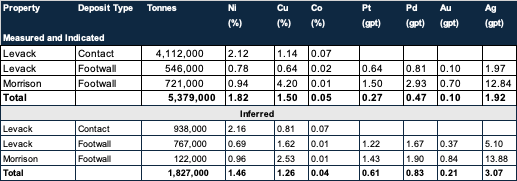Levack Mine
The Levack Mine is adjacent to the McCreedy West mine and connected via a haulage drift on the 1600 level. A significant footwall deposit at Levack (later named the Morrison Deposit) was discovered in 2005.
Levack currently serves as a secondary egress to Glencore’s Craig Mine (including the Onaping Depth project) and McCreedy West. Levack also provides dewatering infrastructure to both McCreedy West and Levack.
History
The Levack Mine was originally developed by the Mond Nickel Company and operated between 1915-1929.. The mine was re-opened in 1937 by Inco Ltd. and historical records for the Levack Mine indicate that the mine produced approximately 60.0 million tons at 1.3% Copper, 2.0 % Nickel, and 1.5 g/t Platinum + Palladium + Gold during the period between 1937-1997. FNX Mining Inc. commenced exploration activities at the Levack property in April 2002 and commenced production in March 2006. Commercial production was achieved in January 2007 from the contact nickel zones, producing 411,000 tonnes grading 0.5% Cu and 1.3% Ni, before nickel mining from the contact zones was suspended at the end of 2008 due to low metal prices. The Morrison Footwall deposit was discovered in 2005 and produced 2.0 million tonnes grading 7.1% Copper,1.4% Nickel and 8.1 g/t Platinum + Palladium + Gold between 2009 and 2018.
Mineralization
The footwall breccia between the McCreedy West and Levack mines remains under explored, and has the potential to host additional footwall Cu-PGE deposits.
Historical Resource Estimate
A mineral resource estimate (MRE) at Levack Mine has been completed internally by KGHM International and is summarized in the table below. The MRE for the Levack Mine is considered historical in nature. Although the resource estimate has been prepared and disclosed in compliance with all current disclosure requirements for mineral resources set out in the National Instrument 43-101 Standards of Disclosure for Mineral Projects (“NI 43-101”) and the classification of the historical resource as a Measured, Indicated and Inferred resource is consistent with current 2014 CIM Definition Standards - For Mineral Resources and Mineral Reserves, a qualified person has not done sufficient work to classify the historical resource estimate as a current mineral resource and Magna is not treating the historical resource estimate as a current mineral resource.

Exploration Potential
The footwall environment at Levack has high potential for discovery of Cu-PGE footwall deposits as demonstrated by the discovery of the Morrison Footwall deposit in 2005. Additional areas of known footwall mineralization include the Keel Zone and No. 3 Footwall Zone, which is the equivalent to known mineralization found on the east side of the Fecunis fault which separates the No.3 and No.4 contact deposits. Additionally, the footwall breccia between the McCreedy West PM Zone and the Levack Morrison Deposit remains relatively underexplored.


